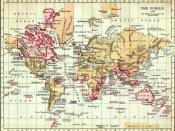Conquest by the Cradle
The common term "thirteen colonies" is misleading. There were thirty-two colonies, but only thirteen of them unfurled the standard of revolt.
White and black inhabitants of the thirteen colonies by 1760 numbered about 1.6 million; by 1775 they had pulled themselves up, largely by their birthrate bootstraps, to about 2.5 million.
Marriage-especially early marriage-was encouraged. An unwed girl of twenty0one could be labeled "an antique virgin."
The colonial birthrate was impressively high, especially in New England, where the people were fertile even if the soil was not.
The bulk of the population was cooped up east of the Alleghenies, although by 1775 a vanguard of pioneers had trickled into the stump-studded clearings of Tennessee and Kentucky.
A Mingling of the Races
Colonial America was a melting pot, and had been from the outset. The population, although basically English in stock and language, was picturesquely mottled with sizable foreign groups.
Heavy accented Germans - 6% pop. or 150,000
Scotch-Irish - 7% pop. or 175,000
Other groups - 5% pop.
By far the largest single non-English group was African. In all, about 350,000 blacks were carried in chains to North America.
The population of the thirteen colonies, though basically Anglo-Saxon, was perhaps the most mixed to be found anywhere in the world.
Frontier Patricians
Glaring social inequalities existed in all the colonies, despite the leveling tendencies of a crude frontier life.
At the top of the social ladder were aristocrats. They were the merchant princes, the landed gentry, the wealthier professional men, and the clergy of the established churches.
The English law of primogeniture fostered social barriers.
Aristocrats were proud of their superior status, and often dressed flashily to show it off, displaying brocades, satins, and laces.
People were often seated in churches and schools according to their...



Colonial Society
You've provided a good range of information in these study notes on colonial society.
I know this isn't a formal essay, but a bibliography would still be very useful for those of us interested in reading more about this topic.
Thanks!
2 out of 2 people found this comment useful.